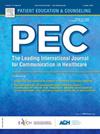Provider use of a participatory decision-making style with youth with ADHD and their caregivers and visit satisfaction
IF 2.9
2区 医学
Q2 PUBLIC, ENVIRONMENTAL & OCCUPATIONAL HEALTH
引用次数: 0
Abstract
Objective
To examine whether youth with ADHD who received a question prompt list and video intervention and their caregivers were more likely to: (a) be asked about their treatment preferences, (b) have their input included into treatment decisions, (c) rate their providers as using more of a participatory decision-making (PDM) style, and (d) be more satisfied with their visits.
Methods
Youth with ADHD were randomized to a pre-visit question prompt list intervention or usual care. Visits were audio-recorded; youth were interviewed after visits; caregivers completed questionnaires. Multivariable linear regression was used to analyze the data.
Results
102 youth with ADHD and their caregivers participated. Providers included youth and caregiver input into ADHD management decisions during 12 % and 20 % of audio-taped visits, respectively. Youth and caregivers of youth who were in the intervention group were significantly more likely to rate providers as using more of a participatory decision-making style. Black youth and caregivers were significantly less likely to rate their providers as using a participatory style than non-Black youth. Youth and caregiver ratings of provider use of a participatory style were significantly associated with greater visit satisfaction.
Conclusion
Both youth and caregivers rated providers high on using a participatory decision-making style. Yet providers could include youth and caregiver input more into ADHD management decisions. Black youth and caregivers rated providers lower on using a participatory decision-making style than non-Black youth and caregivers. Youth and caregivers were more satisfied with visits where they rated their providers as using a more participatory style.
Practice implications
Providers should include both youth and caregiver input into ADHD management decisions. Providers should attempt to use a more participatory decision-making style with Black youth and caregivers.
求助全文
约1分钟内获得全文
求助全文
来源期刊

Patient Education and Counseling
医学-公共卫生、环境卫生与职业卫生
CiteScore
5.60
自引率
11.40%
发文量
384
审稿时长
46 days
期刊介绍:
Patient Education and Counseling is an interdisciplinary, international journal for patient education and health promotion researchers, managers and clinicians. The journal seeks to explore and elucidate the educational, counseling and communication models in health care. Its aim is to provide a forum for fundamental as well as applied research, and to promote the study of organizational issues involved with the delivery of patient education, counseling, health promotion services and training models in improving communication between providers and patients.
 求助内容:
求助内容: 应助结果提醒方式:
应助结果提醒方式:


